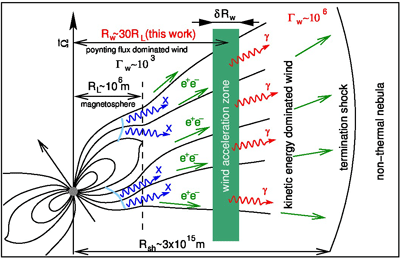TOP > Report & Column > The Forefront of Space Science > 2012 > When Nature does Physics a favour
![]()

After this surprising identification, many other pulsars have been found during the dedicated radio observations. In particular, a pulsar was detected inside the Crab Nebula, an extended source filled with high energy electrons emitting synchrotron radiation (i.e. non-thermal emission produced via interaction with magnetic field). Detailed studies of this exceptionally bright object had led to the concept of plerions, which allowed the broadband nonthermal spectra detected from the Crab Nebula to be explained. The plerion paradigm postulates the existence of three different regions (see Figure 1): (i) pulsar magnetosphere (the close vicinity of the pulsar, where pulsed emission is generated); (ii) pulsar wind (an outflow, which transports the energy from the pulsar to large distances supplying the extended non-thermal source); and (iii) the extended synchrotron nebula. While the radiation components of the magnetosphere and the nebula are essential for the interpretation of the observational data, the wind was assumed to be dim. On the other hand, the properties of the wind have a strong impact on the nebular emission, allowing certain conclusion regarding its basic parameters. Namely, the properties of the Crab Nebula are best explained if the pulsar wind consists of electron-positron pairs, has very low temperature, and is heavily dominated by the bulk kinetic energy. Thus, a model of weakly magnetized cold ultrarelativistic wind was adopted. Although, the description of this model may sound quite sophisticated, in fact, this is the simplest possible model for the wind. Indeed, the observational appearance of the nebula requires the presence of magnetic field, and injection of particles and energy. Assuming an ultrarelativistic velocity of the wind, in the sense that the kinetic energy of the wind particles strongly exceed their rest energy, one provides at once both the particle injection and the supply of the energy required to power the nebula. The approximation of cold wind and small magnetization imply the absence of the wind internal structure, and that the wind carries only the seed magnetic field, that gets amplified in the nebula. It is also important to note that this idealEmodel was suggested to describe the properties of the wind close to the inner boundary of the nebula, while in the region of the wind formation, at the edge of the magnetosphere, the wind remained unconstrained. 
Despite the apparent simplicity there was no significant progress in the understanding of pulsar winds for more than 25 years, and it appeared to be one of the most mysterious phenomena in astrophysics. The key difficulty in its further study is related to the low temperature of the wind: although the winds electrons are ultrarelativistic, they represent a form of dark substanceE in the sense that they move together with the magnetic field and therefore do not emit any synchrotron radiation. Actually, the only channel through which the pulsar wind can emit potentially detectable radiation is the inverse Compton scattering, i.e. the process when a high energy electron up-scatters a low energy photon to the gamma-ray energy band (for the conditions expected in the pulsar wind). However, any observational study of the pulsar wind emission is a very difficult task, since this signal should be differentiated from the emission components produced by two other much brighter emitters: the pulsar itself and the nebula.
|
||||||




